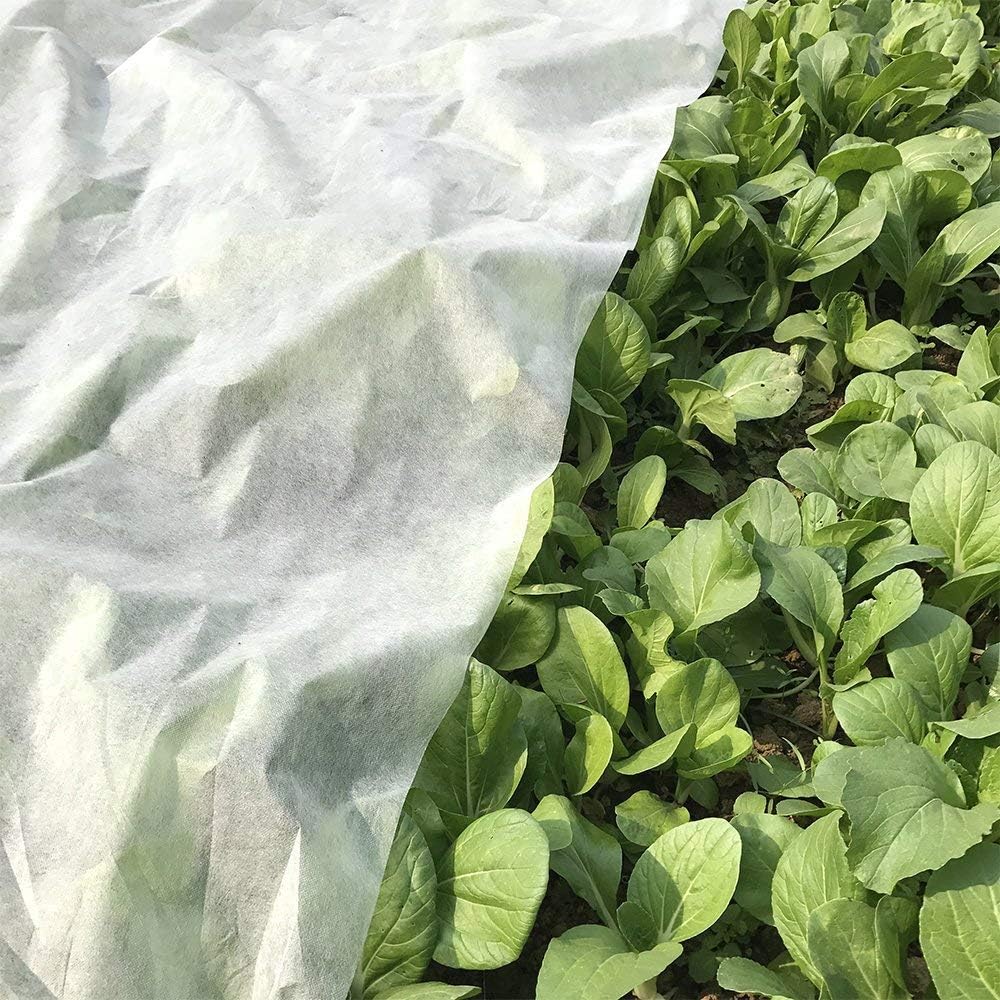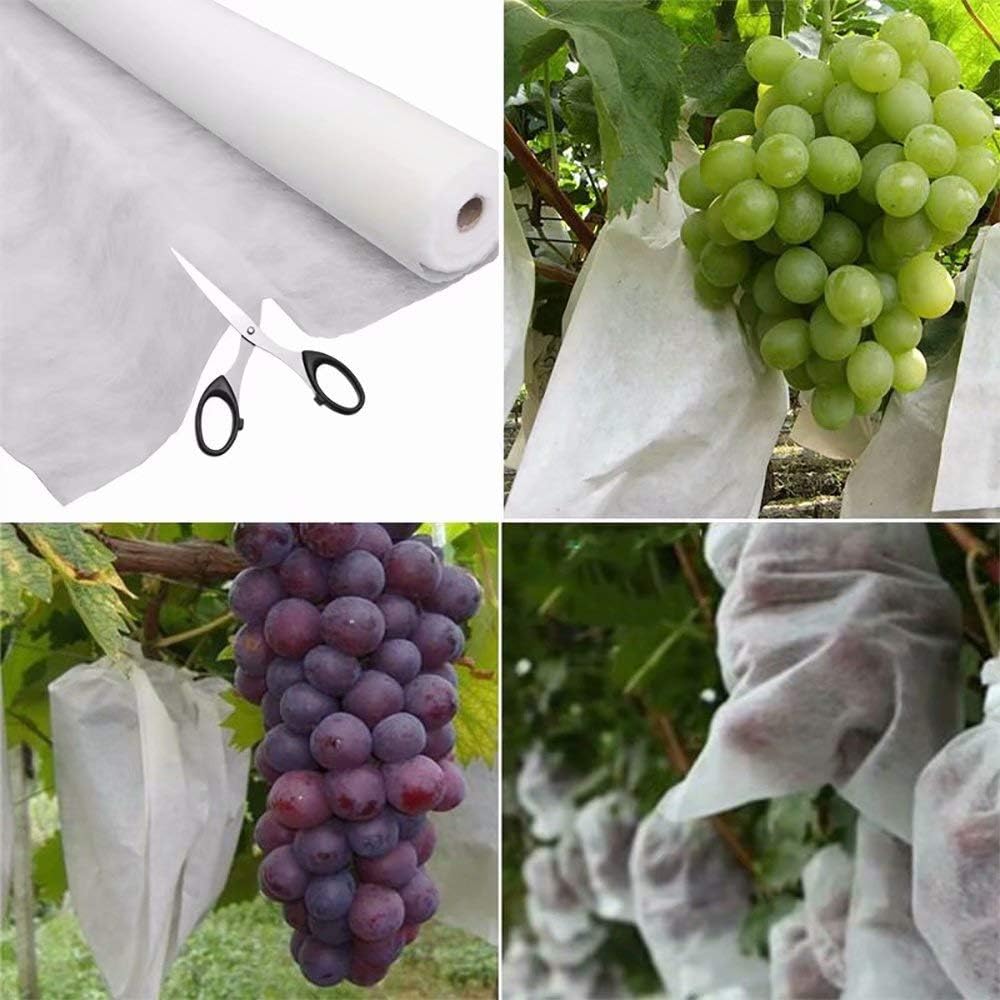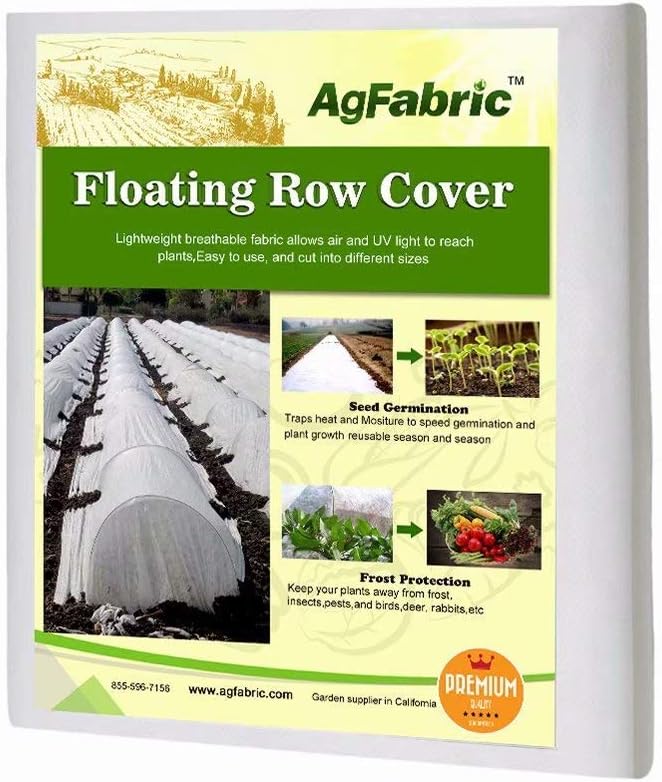Contents
- 1 Unlock the Potential of Floating Row Covers
- 2 Why Floating Row Covers Are a Gardener’s Best Friend
- 3 Choosing the Right Floating Row Cover for Your Garden
- 4 Step-by-Step: Setting Up Your Floating Row Covers
- 5 Maintenance Tips for Maximum Effectiveness
- 6 The Top Floating Row Covers on the Market
- 7 Final Thoughts: Enhance Your Garden’s Vigor
- 8 Frequently Asked Questions
- 9 Author
Key Takeaways: Floating Row Cover Basics
-
Floating row covers are versatile garden tools that help regulate temperature, protect plants from pests, and extend the growing season.
-
They come in various materials and weights, each suited for different gardening needs and climates.
-
Setting up floating row covers is straightforward, requiring measuring, cutting, and secure anchoring to protect your plants effectively.
-
Maintenance, including monitoring plant health and proper storage, ensures row covers last multiple seasons.
-
The Agfabric Plant Covers Freeze Protection is a top choice for gardeners seeking reliable frost and pest protection.
Gardening is not just about planting seeds and waiting for them to grow; it’s about nurturing and protecting your plants through every stage of their life. That’s where floating row covers come into play—a simple yet ingenious solution for gardeners looking to give their plants the best possible chance to thrive.
Unlock the Potential of Floating Row Covers

Let’s dive into the world of floating row covers. Whether you’re a seasoned green thumb or just starting your gardening journey, understanding how to use these covers can be a game-changer for your garden’s productivity and health.
What Are Floating Row Covers?
Floating row covers are essentially blankets for your plants. They are made from lightweight materials like polypropylene or polyester that ‘float’ over your plants, creating a protective barrier without the need for a supporting structure. They are permeable, allowing light, water, and air to reach the plants while keeping out unwanted guests like insects and cold temperatures.
Types of Floating Row Covers
Not all floating row covers are created equal. They come in various weights and materials, each with its own set of benefits:
-
Lightweight covers are perfect for insect protection and allow maximum light transmission.
-
Medium-weight covers offer frost protection down to certain temperatures, making them ideal for extending the growing season in spring and fall.
-
Heavyweight covers provide the most insulation for your plants, protecting them from harsh winter conditions.
Each type of cover serves a unique purpose in the garden, and selecting the right one depends on your specific needs.
Why Floating Row Covers Are a Gardener’s Best Friend

Extend the Growing Season
One of the most significant advantages of floating row covers is their ability to extend the growing season. By insulating your plants from the cold, you can start your garden earlier in the spring and keep it going later into the fall. This means you can enjoy fresh produce for a more extended period!
For example, a gardener in a cooler climate could use a medium-weight cover to protect tender lettuce seedlings from a late spring frost, giving them a head start on the season.
Besides that, floating row covers can also protect plants from excessive heat, making them versatile for use in both cool and warm seasons.
Protection from Pests and Harsh Weather
Plants are like a buffet for pests, but floating row covers can help keep these uninvited diners at bay. By creating a physical barrier, you can prevent insects from laying eggs on your plants and shield your tender greens from birds and other animals looking for a snack.
Furthermore, row covers can protect your garden from the whims of the weather. They shield plants from wind, hail, and heavy rain—conditions that can damage or even destroy young seedlings.
Choosing the Right Floating Row Cover for Your Garden

Material and Weight Selection
Choosing the right floating row cover starts with understanding the material and weight that best suits your garden’s needs. For example, if you’re looking to protect against frost, a heavier weight will be necessary. On the other hand, if you’re more concerned about insects, a lightweight, breathable cover will do the trick.
Because different plants have different needs, it’s important to match the row cover to the crop. Delicate herbs might need a lighter touch, while hardy vegetables can handle a heavier cover.
Size and Scalability for Your Garden Beds
Size matters when it comes to floating row covers. You’ll want to ensure the covers are large enough to drape over your plants with extra room on the sides to secure them in place. It’s always better to have a little too much cover than not enough—plants grow, and so should their protection.
When planning your garden layout, consider the scalability of using row covers. As your garden expands, so can your use of these protective fabrics. It’s a simple step that can have a big impact on your garden’s success.
Now that you’ve selected the perfect floating row cover for your garden, it’s time to get your hands dirty and set it up. Don’t worry, it’s not as complicated as it might seem. With a few simple steps, you can have your garden snug and secure under its new blanket.
Step-by-Step: Setting Up Your Floating Row Covers

Setting up floating row covers is a straightforward process that can be done in an afternoon. With the right preparation, your plants will be protected in no time.
Preparation: Measuring and Cutting
Before you can protect your plants, you need to measure your garden beds to ensure you cut your row cover to the right size. Remember to allow for extra material on all sides to secure the cover to the ground. Once you have your measurements, cut the cover to size using scissors or a utility knife. Be sure to cut on a clean, flat surface to avoid snags or tears.
Here’s a tip: If you’re covering a large area or several rows, it may be easier to cut your row cover in sections rather than trying to handle one large piece.
For example, if your garden bed is 4 feet by 8 feet, you’ll want to cut your row cover to at least 6 feet by 10 feet. This gives you an extra foot on each side to secure the cover.
Secure Anchoring Techniques
Once your row cover is cut to size, it’s time to secure it. There are several ways to anchor your cover:
-
Use garden fabric staples or U-shaped pins to secure the edges directly to the ground.
-
Place heavy objects like bricks, stones, or boards along the edges.
-
Create a more permanent solution by installing PVC hoops and clipping the cover to the hoops with clothespins or special row cover clips.
Whichever method you choose, make sure the cover is snug against the ground to prevent pests from sneaking in and to retain warmth.
Maintenance Tips for Maximum Effectiveness
Maintenance is key to getting the most out of your floating row covers. Regular checks will ensure they continue to protect your plants effectively throughout the season.
Monitoring Plant Health Under Covers
Regularly lift the covers to check on your plants. Look for signs of stress, such as wilting or yellowing leaves, which could indicate overheating or lack of water. Also, be on the lookout for any pests that may have found their way in. Catching issues early can make all the difference.
Most importantly, adjust the covers as your plants grow. Ensure they have enough room and that the cover isn’t restricting their development. If you’re using hoops, raise the cover higher as needed.
Cleaning and Storage for Longevity
At the end of the season, clean your row covers before storing them. Shake off any dirt and rinse them with a hose if necessary. Let them dry completely to prevent mildew, then fold and store them in a dry place away from rodents. Proper care will extend the life of your row covers for several seasons.
Remember, floating row covers are an investment in the health and productivity of your garden. With proper setup, anchoring, and maintenance, they will serve you well for years to come.
The Top Floating Row Covers on the Market

There are many floating row covers available, but one that stands out for its quality and effectiveness is the Agfabric Plant Covers Freeze Protection.
Agfabric Plant Covers Freeze Protection
This particular cover is made from high-quality, UV-stabilized, spun polypropylene fabric. It’s durable, lightweight, and comes in various sizes and weights to suit any gardening need. Whether you’re looking to protect your garden from frost, pests, or overheating, Agfabric has you covered—literally.
If you’re ready to give your plants the protection they deserve, you can find the Agfabric Plant Covers Freeze Protection on Amazon. It’s a reliable choice for gardeners who take their plant care seriously. Buy Agfabric Plant Covers Freeze Protection
Comparing Brands: Features and Benefits
When shopping for floating row covers, it’s important to compare different brands to find the best fit for your garden. Consider the essential gardening tools that can complement your choice and help you make an informed decision:
|
Brand |
Material |
Weight Options |
UV Stabilization |
Permeability |
|---|---|---|---|---|
|
Agfabric |
Polypropylene |
Light, Medium, Heavy |
Yes |
High |
|
Blanket Plant Cover |
Polyester |
Medium |
No |
Medium |
|
Care Home cover |
Natural Fiber |
Light |
Yes |
Low |
As you can see, Agfabric offers a range of options with the added benefit of UV stabilization, which can prolong the life of your row cover. It’s a top choice for gardeners looking for durability and versatility.
With the right floating row cover, you’ll not only protect your plants but also create an environment where they can flourish. The result? A healthier, more bountiful garden that will be the envy of your neighbors.
But even the best garden tools encounter wear and tear. So, what do you do when your trusted floating row cover gets a rip or a hole? Don’t worry; there’s no need to buy a new one right away. With a few clever repair hacks, you can extend the life of your row cover and keep it in action for many more seasons.
Repair Hacks for Tears and Holes
For small tears and holes, waterproof tape designed for outdoor use can be a quick fix. Just clean the area around the tear, cut a piece of tape to size, and apply it to both sides of the row cover. For larger damages, you might need to patch with a piece of row cover material. Simply cut a patch that covers the damaged area plus an extra inch all around, and sew it on with durable, weather-resistant thread.
Another solution is to use a heat-bonding fabric tape that fuses the patch to the cover with the help of an iron. Be sure to set the iron on a low setting to avoid melting the fabric. This method works best on polypropylene or polyester covers.
Remember, the goal is to maintain the integrity of the row cover’s barrier against pests and weather. A well-maintained cover can save you time and resources in the long run.
Final Thoughts: Enhance Your Garden’s Vigor

Floating row covers are an invaluable addition to any gardener’s toolkit. They not only protect your plants from the unexpected challenges of nature but also enhance growth by creating a stable microenvironment. By choosing the right type of cover, installing it properly, and maintaining it with care, you can enjoy a thriving garden that produces more of what you love.
And if you’re looking for a top-quality row cover to get started, consider the Agfabric Plant Covers Freeze Protection. With its durability and range of options, it’s a smart investment for serious gardeners.
Frequently Asked Questions
Can floating row covers be reused?
-
Yes, floating row covers can be reused for multiple seasons if they are handled with care and stored properly.
-
Clean them at the end of the season and store them in a cool, dry place.
-
Repair any tears or holes to extend their usability.
With proper care, your floating row covers can be a long-term ally in your garden, providing consistent protection year after year.
How long can plants remain covered?
Plants can remain covered as long as necessary, provided that the row cover is of the appropriate weight for the weather conditions and the plants have enough room to grow. Be sure to monitor the plants regularly for any signs of stress.
Are floating row covers effective against all pests?
Floating row covers are effective against many pests, but not all. They are best at keeping out insects and small animals. For burrowing pests or birds that can peck through the fabric, additional measures may be needed.
However, for the vast majority of common garden pests like aphids, beetles, and caterpillars, row covers can provide an excellent line of defense.
Do floating row covers need to be removed daily?
No, floating row covers do not need to be removed daily. They are designed to allow light, air, and water to reach the plants while staying in place to protect them. However, it’s important to lift the covers periodically to check on the plants’ health and growth.
Can water and sunlight penetrate all types of floating row covers?
Yes, all types of floating row covers are designed to be permeable to water and sunlight, although the degree of permeability varies with the weight and material of the cover. Lightweight covers allow more light and water to pass through, while heavier covers offer more insulation with slightly reduced light transmission.



